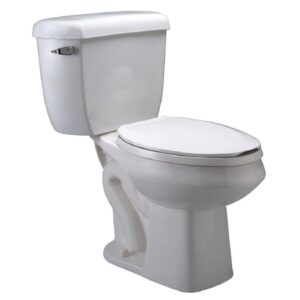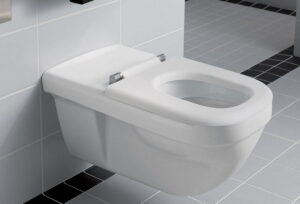
A vital part of human life, toilets have been a subject of innovation for years now. Different people will need different types of toilets for various reasons. You could be thinking about installing a new toilet in place of an old one, or within a building under construction. Either way, you should begin by exploring the types of toilets in the market before choosing the one that fits your needs.
Here is a systematic analysis of the various types of toilets in existence based on their functionality, usability, and design. Before choosing your preferred toilet, this catalog will give you an idea of the toilet that will satisfy your needs.
Recommended Best Toilets: Top 4 WoodBridge Toilet Reviews
Mode of Waste Disposal
This criterion categorizes toilets by the method through which they get rid of waste.
Gravity Fed Toilets
Table of Contents
Gravity-fed toilets are the most popular kinds of toilets in this measure. These toilets use a gravity-based mechanism to flush down waste. Above the bowl, a tank holds water, which is restricted by a valve. When the valve opens via a flush trigger, water rushes into the bowl and forces the waste out through the trap way. So that they clean out the bowl thoroughly, most gravity-fed toilets also have a siphoning mechanism in the bowl.
They are relatively quiet and have few moving parts, hence few and easy maintenance requirements.
Pressure Assisted Toilets
Like the gravity-fed toilets, pressure-assisted toilets have a water tank above the bowl, which holds the water that cleans out the bowl. However, they edge the gravity-fed toilets out with an extra feature. They have pressurized air that pushes water out of the water tank with incredible force.
This pressure makes these toilets more effective in pushing waste out through the trap way. Therefore, clogging with solid waste is rarer than when using gravity-fed toilets. The only downside is that pressure-assisted toilets are much noisier. For public washrooms or ones in large households, these toilets are a great choice.

Dual Flush Toilets
Dual-flush toilets are rookies in the market. They are an innovative blend of pressure-assisted toilets and gravity-fed toilets. The name, the dual flush toilet comes from the two flushing options, half flush and full flush. The gravity-fed system is the preferred option for liquid waste, and by choosing the half flush option, you activate it.

On the other hand, the full flush, with the pressure-assisted system produces a lot of force, and is, therefore, used to get rid of solid waste. They save water much more than the gravity-fed toilets. They also are understandably pushing the previous two out of the market.
See More: Best American Standard Toilet – Reviewed By Experts
Double Cyclone Toilets
Far rarer than dual-flush toilets, double-cyclone toilets are a creative new technology that uses very little water. The economy on water doesn’t compromise the flushing power either. The water delivery on the rims is through two nozzles rather than holes. Their main highlight, however, is the power from the “double-cyclone” and not the economy on water. Nonetheless, it still saves more water than gravity-fed toilets.
Composting Toilets
Composting toilets have vessels beneath the toilet basins where the waste is collected. They don’t use water and require emptying upon filling up. Composting toilets are preferable when the other four aren’t available. This instance may be during long-term outdoor activities such as camping or worksites. If you’re remodeling your house and replacing the toilets, waterless toilets also come in handy.

Flush Type
If you want any of the toilets apart from the waterless toilet, you might be interested in finding out the types of toilets based on their flush models.
Single Flush Toilets
Single flush toilets are the most common types of toilets. Every time users trigger the opening of the valve, they prompt a single flush of similar force and water capacity. Being very common, they’re the cheapest and most widely available option.
Double Flush Toilets
As earlier mentioned, double-flush or dual-flush toilets employ two levels of flushing. The half-flush gets rid of the liquid waste while the full-flush takes care of the solid waste. To half-flush, you only need to press the button or lever lightly. For the full-flush, you must push it more forcefully.
With this complexity, the double-flush toilets are more difficult and expensive to buy and maintain. With their rarity, their designs are also few.
Touchless Flush Toilets
By far, the most hygienic toilets, touchless flush toilets don’t require the user to press a button or lever to flush the toilet. The toilet detects when a person is done using the toilet, using motion sensors, and it flushes automatically.
This toilet is ideal for places where there are many users, such as a crowded workplace or public washrooms. It isn’t a difficult feat, to convert your double or single-flush toilet to a touchless one.
Flushometer Toilets
Flushometer toilets use a mechanism that facilitates flushing without tanks. They use a lot of water and generate a very high flushing power. The lack of tanks saves space, which along with the flush power makes them popular with commercial buildings.
Mount Type
Here, we consider where the toilet is mounted, either on the floor or on the wall.
Floor Mounted toilet
Floor mounted toilets have a bowl that is fixed to the floor while the tank is either on the wall or fixed at the back and on the top of the bowl. These types of toilets are the most common and easier to install than wall-mounted ones. Under this, there are two more types:
Close-coupled Toilet
Close-coupled toilets consist of a bowl and tank in a single unit, with the bowl holding the toilet to the floor. These toilets are growing very popular right now.
Back-to-wall Toilet
These types of toilets, like close-coupled ones, are fixed to the floor. Their peculiarity lies in the pipework and the water tank. These are hidden in the wall or in some furniture behind the bowl. They will save your bathroom space better than close-coupled toilets.
Wall Mounted Toilet
A rare sighting, wall-mounted toilets feature a toilet bowl attached to the wall and a hidden tank. The flushing button or plate sits on the wall. The water tank is within or behind the wall, away from sight.
This style saves space, but you have to install it as you construct a building for architectural considerations. These toilets also make for easy cleaning and have an elegant look to them.
Number of Pieces
In this category, the toilets are classified with the number of pieces it takes to assemble them.
One-piece Toilet
As the name suggests, one-piece toilets combine the bowl, bidet toilet seat, tank, and trap way in one ceramic unit. This layout makes these types of toilets easy to install and clean. Even though replacing parts isn’t an option, their compact nature makes them durable.
Two-piece Toilet
Two-piece toilets come in two pieces, with the bowl, seat, and trap way being independent of the tank. Replacing parts of these toilets makes them a longer-lasting option, albeit a harder one to clean, as compared to one-piece. You can buy the two pieces with different styles. They are the most common types of toilets and are, therefore, available in a broader range of styles.
Dimensions
Standard Height Toilets
The standard height of a toilet from the floor to the seat is about 15-17 inches. These are the most common toilets, but various factors may make you prefer a toilet of a different height.
Comfort Raised Toilets
Comfort raised toilets are higher than standard height toilets. A higher seat about 19 inches is better for physically challenged people, who prefer to bend less. This height is much closer to standard chair height.
If you intend for a toilet to be used by little children or shorter people, a toilet 15 inches or shorter could be a better option.
Bowl Design
The shapes of toilet bowls from an aerial view differs with preferences.

Elongated Toilet Bowl
Elongated toilet bowls are oval-shaped and are long from the back to front, about 18 inches long. Those who prefer these toilets praise their comfort.
Round-front Toilet Bowl
Round-front toilet bowls are round and smaller than elongated ones. They save on space but are less comfortable. They are excellent for commercial washrooms where space is precious.
Square Toilet Bowl
Square toilet bowls save space, like the round-front ones. Their edge is in their stylish and uncommon look.
Compact Elongated Toilet Bowl
Compact elongated toilet bowls blend the best of elongated and round-front toilet bowls. They have the round layout but are spacious, as well.
Rectangular Toilet Bowl
Like elongated toilet bowls, rectangular ones are very comfortable. They are longer than the square toilet bowls from back to front. However, these ones add the unique look that you get with square toilet bowls.
Trap way visibility
The trap way is the link between the toilet bowl and the plumbing of a building. Mostly, they are s-shaped, but some are p-shaped. People prefer the p-shaped ones for the upper stories of most commercial buildings because of the lack of space on the floors.
The visibility of the trap-way is a criterion for categorizing toilets too.
Exposed Trap Way Toilets
The trap way in exposed trap way toilets is visible on the sides of the toilet. Caps conceal the bolts that pin the toilet to the floor.
Concealed Trap Way Toilets
Concealed trap way toilets hide the s-shape of the trap way on a smooth exterior. Like in the exposed trap way toilets, discreet caps cover the bolts that hold the toilet in place on the floor.
Skirted Trap Way Toilet
The only difference that the skirted trap way toilet has from the concealed trap way toilet is that it has no exposed bolt caps. Its layout is smooth from the seat to the floor, with no visible caps or bolts.
Advanced Intelligence Toilets
Smart toilets are a luxurious approach to toilets, with amazing functionalities. These extra features include automatic music, which plays when someone approaches the toilet. Some designs have an automatic opening and closing of the toilet seat covers. Smart toilet seats have heating, warm water and air dryer, and deodorizing mechanisms. Some of these toilets can even distinguish between a male and a female user.
Sitting Position Design
The first criterion for classifying toilets is the position a person assumes when using it. Toilets fall into either of two categories in this standard:
Squatting Design Toilets
Toilets with a squatting design feature an open pan on the floor of the toilet space over which the user squats.
Sitting Design Toilets
The sitting design is more comfortable since it has a raised bowl, which has a rim on which the user sits. This rim often has a seat and a cover, which flap on and off it. This design, also known as the European or Western Waters Closet, is more common than the squatting one.
Final Verdict
Depending on your needs, you might prefer any toilet on this list. Some save water, while others capitalize on the flushing power. Some are easy to install, while others are easier to maintain. Other toilets are better for household needs than for commercial buildings.
Hopefully, this analysis helps you settle on a stellar option that will serve you well.
